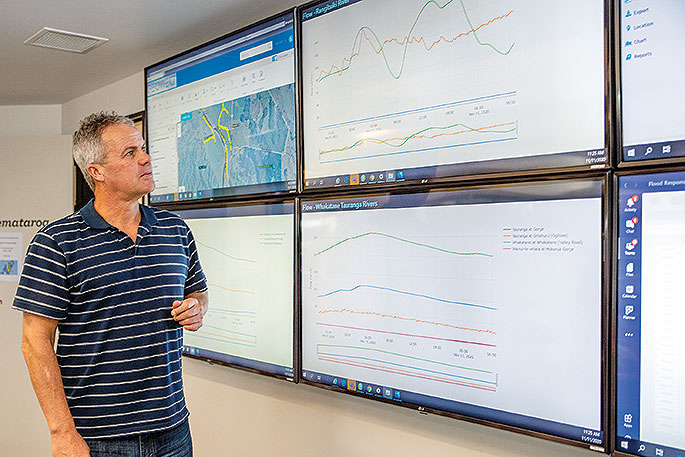Learnings from the past coupled with modern technology are helping to ensure the region's flood team can react quickly in an emergency.
The Bay of Plenty Regional Council's flood team has moved into its new high-tech customisable flood room based at the council's offices in Whakatane – debatably the best flood room of any regional council in the country.
The council has a 24/7 roster of flood managers who are constantly monitoring weather patterns and potential impact on river levels.
When the flood room is activated, the team can monitor major events and provide up-to-date information to emergency services and district and city councils to inform decisions such as when and how to evacuate, with key information livestreamed to six large screens mounted on the wall.
Regional council engineering manager Mark Townsend, who leads the group, says his team is always striving to do better and was constantly challenging itself, so it worked seamlessly in an emergency.
Recently, the team, drawn from a variety of disciplines across the council, tried out the flood room by taking part in an exercise based around a one-in-50-year flood on the Waioeka River and a one-in-20-year flood on the Otara River.
In the simulation, both rivers topped their stopbanks and flooded rural farmland.
Townsend says he's impressed with how his team handled the simulation and there was a focus on communication, specifically getting warnings out as soon as possible, for example, to farmers to move stock in the first instance and to other authorities as the situation developed.
He says the team has been working on communication since the Edgecumbe floods, an emergency where he acknowledges information could have been shared better.
Following this realisation, the council hired people specifically to communicate technical information to those who needed it in layman's terms.
The council also has a pool of 70 people trained to report back to the flood room from the field to ensure there is accurate up-to-date information throughout an emergency event.
Townsend says it's important to have trained people to provide information because although the public could be helpful calling in potential threats, often the information provided needed to be checked to ensure the correct decisions could be made.
Each of these 70 people underwent training every two years.
'With our new flood room and with all these specially trained people reporting in live-time, all the information we need is at our fingertips.
'We can receive photos and videos of what is happening in the field in a matter of seconds. Everything in an event is time critical.”
The reports provided by the team stay on the map screen with a location flag.
The flood team can then click this location flag and see all the reports that have come in from that location during the event.
The map also shows key council infrastructure such as stopbanks, drains and pump stations.
In another recent flood exercise, the team practised leaving the flood room in an emergency, in this case a fire alarm was activated prompting an evacuation of the building.
The team travelled across Whakatane and set up in the East Bay REAP offices in 25 minutes.
The team also learns what it can from historical events dating back as far as 1315.
Evidence has been found that in 1315, an eruption caused a temporary blockage that saw Lake Tarawera rise 30 metres.
The blockage collapsed and flooded what would eventually become the Kawerau settlement under 30 metres of water.
A similar blockage occurred in the Tarawera eruption in 1886.
The flood team monitors lakes around the district and would notice well in advance if a similar situation was to occur.
Every real flood and flood exercise the team takes part in helps it to develop its skillset.
Staff involved in flood management from other regional councils have been asking to travel to Whakatane and learn from its team.
Townsend says the council is working on a standardised system so that if flood officers were called to help in another region, they would be familiar with the system straight-away.
'We want to keep everything as simple as possible while utilising every tool we can."




1 comment
Good lord
Posted on 02-12-2020 15:31 | By Slim Shady
No expense spared. Plenty of TVs for the 70 odd staff to watch while they are waiting for the 1 in 100 year rain event.
Leave a Comment
You must be logged in to make a comment.